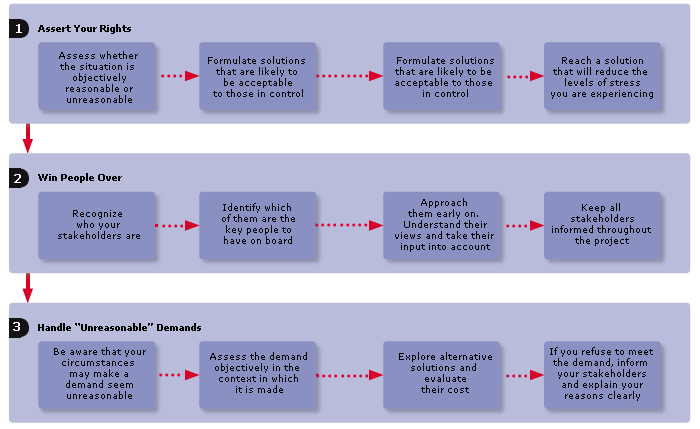“Unreasonable” Demands
Demands that seem unreasonable can be a huge source
of stress, although they will often arise through misunderstanding. A
simple process of evaluating the demand can go a long way towards
reducing the stress.
Avoid Unintentional Pressure
Innocent situations
can often reinforce one another to create stressful and unfeasible
demands on you. Several customers may be clamouring for the completion
of large jobs when you have the resources to service only a few of them.
Within your organization, requirements can be misunderstood when they
are transmitted from person to person, the importance of deadlines can
be overstated, and requests can be made in ignorance of key information.
Consider Your Response
NOTE
A demand is unreasonable only if there is no good reason for it
We tend to react
emotionally to such demands, feeling that they are being made by a “bad
person”. In reality, most people are fair and rational, and often the
demands are objectively reasonable. In the rare instances when the other
person does have a “hidden agenda” and actually wants you to feel or be
disadvantaged, you will need to know what course of action is open to
you if you refuse to meet the unreasonable demand. You will also need to
have an idea of the future value of the relationship, as a sacrifice
now may bring benefits later.
Explore the Reasons
People may
make seemingly unreasonable demands for a range of good reasons. Perhaps
the person making the demand is aware of a consideration that is of
great concern to the organization. Always try to find the underlying
reason for a demand before dismissing it.
Assess the Demand
When you are faced with an “unreasonable” demand,
rather than feeling overwhelmed or responding with anger, make sure of
your facts and reach a balanced conclusion in which you can have
confidence.
Run through the process in this chart, checking at each stage to see whether the demand is, in fact, reasonable.
In the case of each demand being made of you, make sure that your response is appropriate.
Make a Good Case
Check your information and assumptions
Look at the situation from the other person’s perspective
Explore your alternatives and the cost of each
Explain your perception assertively
Agree on the best way forward, and manage the consequences
Make sure you
fully understand what you are being asked to do, confirm delivery times,
and check whether there is any flexibility in the deadline that you
have been given. You may find that the demand isn’t as impossible to
action as you first thought.
Perhaps he is unaware
that you are working at full capacity or that a key member of your team
has been seconded to another project. Explain the situation and try to
negotiate an appropriate solution.
A little lateral thinking may help you to find a solution that will suit everyone. Evaluate the impact of any possible solution.
Arrange a meeting and
explain the situation to the other person as you see it, in an assertive
manner, making your case clearly and without any hint of aggression or
frustration. If you behave in a reasonable manner throughout, the other
person will probably mirror your good behaviour.
If you really can’t agree on a fair way to proceed, one or other of you will have to concede gracefully.
Summary: Being Pro-Active


In your working life, you are subject to various forms of external
control. This lack of personal control can be a source of considerable
stress. When you find that the demands and influence of others are
having a negative effect, the best strategy is usually to take the
initiative and talk to those concerned in order to remedy the situation.